Carnivores of Belize
There are at least 66 carnivore species found in Latin American. The nine listed here are the among the most common of the mammalian carnivores found in Belize.
Nine-banded Armadillo - - - Dasypus novemcinctus
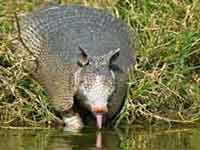
The Nine-Banded Armadillo spends most of its active hours digging for food and building burrows, snuffling almost constantly. The Nine-banded Armadillo goes about its business with a steady, stiff-legged jog The armadillo is primarily nocturnal during hot weather and diurnal during cooler weather. This animal produces several grunts, and other low-volume sounds that appear to derive from breathing or sniffing. It will sometimes stand nearly upright, supported mainly by its tail, to sniff the air for danger or food.
It roots and searches rotting logs for insects and snuffs about in vegetation for ants and invertebrates. It also eats crayfish, amphibians, reptile and bird eggs, and carrion.
For such a clumsy-looking animal, the armadillo is surprisingly swift. When startled it may jump vertically and erratically, then run. It can swim short distances, gulping air to inflate its intestines for increased buoyancy, and can cross small streams or ponds by walking underwater on the bottom.
When approached, it escapes by running away or curling its body to protect its vulnerable belly; it can also burrow underground with amazing speed. Armadillos sleep in nests placed underground, in a crevice, or on the ground. Underground burrows may be up to 3 feet (1 m) in depth, with one or more entrance tunnels. Dens of several adults may be clumped together, and one adult may have more than one den.
Coyote - - - Canis latrans goldmani
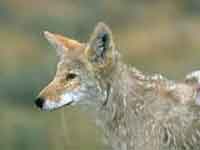
Coyotes range throughout North America, from northern Canada and Alaska, to Central America. They are abundant in Mexico and most countries in Central America, but do not extend to South America. There are 19 recognized subspecies of coyote, with 3 in Central America. They are found in a wide variety of habitats, from tundra to forest to scrubland to the outskirts of cities. They will thrive in an area just as long as there is a prey base.
The coyote is one of the most successful land predators on Earth, behind the grey wolf. Its name comes from the Aztec word 'coyotl' which means "barking dog". They have an incredible range in size and coloration. Coyotes from the north are larger (avg. 75 lb (34 kg)) than those farther south, such as Mexico (avg. 25 lb (11 kg)). Their color is generally a light grey with black ticking and pale under-parts. Coyotes that live in the mountains tend to be darker and desert coyotes tend to be more yellowish in color. They may have cinnamon markings on their face and sides of their body.
Coyotes are opportunistic feeders, as well as scavengers. They will eat reptiles, rodents, fish, amphibians, birds, insects, crabs, carrion, fruits, and deer. They also eat livestock and poultry, for which they are hotly persecuted as vermin. Coyotes usually hunt at night.
Coyotes hunt alone when pursuing small game, like mice. They will hunt in pairs or small groups when pursuing larger prey like deer. One usually is responsible for flushing the game out, while the others wait around to ambush it and help take it down.
Gray Fox - - - Urocyon cinereoargenteus
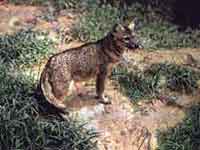
Gray foxes occur throughout most of the southern half of North America from southern Canada to northern Venezuela and Colombia. They do not occur in portions of the mountainous northwestern United States, the Great Plains and eastern Central America. Gray foxes are found in deciduous woodlands, but are occasionally seen in old fields foraging for fruits and insects. They do not prefer agricultural habitats. Gray foxes resemble small dogs with bushy tails. They are distinguished from most other dogs by their grizzled upper parts, buff neck and black-tipped tail. Males are slightly larger than females.
Grison - - - Galictis vittata caraster

Grison, known in Belize as Bushdogs, range throughout Central and South American woodlands and grasslands. They can also be found near inhabited buildings, at an altitude up to about 4000 feet. The name "Grison" comes from the French word "gris," which means "gray."
The coat consists of long, soft hairs. A white stripe runs from the forehead over the ears as far as the shoulders, and separates the black face, throat, and chest from the grizzled gray back.
The general appearance is ferret like with a long body and short legs, but the color pattern is distinct. The head and body are about 20 inches long, with a tail of about six inches. They weigh about three to seven pounds.
The grison hunts both night and day, and is often seen in small groups. They live in crevices in rocky areas and beneath tree roots. They feed on chinchillas, viscachas, and other rodents, which they kill with a swift bite on the back of the neck.
Long-Tailed Weasel - - - Mustela frenata perda

The Long-Tail Weasel's range includes most of North America, extending from Southern Canada south through Central America to northern South America. It has the largest distribution of any mustelid in the Western Hemisphere. Their habitats range from crop fields to small wooded areas to suburban areas. Their burrows and nests are in hollow logs, rock piles, and under barns. Sometimes instead of building a new nest, long-tailed weasels take over the burrow of one of their prey.
Long-tail weasels have long slender bodies with short legs. Their long, bushy tails are about the same length as their bodies. Males are generally larger than females. Their heads are small and narrow with long whiskers. They have short, soft under-fur covered by shiny guard hair. They are cinnamon brown in color with white under parts that have a yellow tinge.
Neotropical Otter - - - Lontra longicaudis

The Neotropical otter lives in the lakes, streams, swamps, and lagoons from Northwest Mexico to South America. Their range in South America includes Uruguay, Paraguay, Bolivia, Brazil, and northern Argentina. They are the most common otter species in Mexico, and have the widest range of any South American otter species.
Like all river otters, the Neotropical has a thick, cylindrical, elongated body set on short, stocky legs. Their short, dense fur is a brownish-grey color with paler undersides and throat. The thick, conical, muscular tail tapers from the base to the tip.
They have a soft, wooly undercoat covered by coarse, shiny guard hairs. These guard hairs keep the undercoat dry when the animal is wet, keeping the animal warm and insulated. Unlike other aquatic mammals like seals, otters lack an insulating layer of body fat, so they rely solely on their fur to keep them warm and dry.
Although they feed mainly on fish, crustaceans, and mollusks, they are opportunistic feeders, and will also feed on insects, small reptiles, birds, and small mammals. They consume smaller prey in the water but take larger prey to the shore before eating it.
Striped Hog-Nosed Skunk - - - Conepatus semistriatus
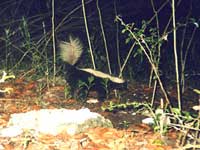
Striped Hog-Nosed Skunks have a black back with a white area beginning at the nape of the neck and extending backward, then branching into two stripes separated by a narrow black stripe. The tail is covered with an array of black and white hairs that are shorter than in other skunks. They have a broad hog-like nosepad, from which comes its common name.
The hog-nosed skunks dines mainly on insects, lizards, and birds. A large portion of the insect remains found in the skunks droppings appeared to be from termites
This species has no known predators.
Spotted Skunk - - - Spilogale putorius
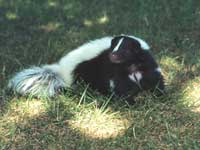
Spotted Skunks are found throughout much Belize. They occupy mostly wooded areas. They are also found in tall-grass prairies or rocky habitats. The live in holes either self-dug or abandoned burrows from other animals. Spotted Skunks prefer to live with several skunks in one burrow, Except during mating season.
These skunks have large bodies that are low to the ground with a small tapered head. The hair is longest on the tail and shortest on the head. They have 34 teeth. There is a small white spot on the forehead and one in front of each ear.
There are six distinct white stripes on the anterior part of the body. The posterior part of the body has two interrupted white bands, and one spot on each side of the rump and two more at the base of the tail.
Spotted Skunks are mostly nocturnal. They are much more alert and active than most skunks. The spotted skunk is noted for its characteristic "handstand" stance that it takes when threatened. A foul-smelling oily secretion from the skunk's anal glands can be projected up to 5 feet and is usually directed at the face of the threatening animal.
These skunks are miss-classified as Carnivores. They eat cottontails and corn in winter. In the spring they feed on native field mice and insects, in summer on insects with small birds, and birds' eggs and amounts of fruits and the fall they eat predominately insects.
Tayra - - - Eira barbara senex
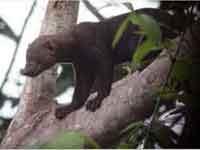
Tayra are found throughout most of Central and South America. They prefer woodlands and areas rich in vegetation.
The body is slender with legs of medium length, much like the marten. The long neck supports a head that is quite large in relation to the body with round, short ears. The dense, short, very soft coat is brown with yellowish areas in some individuals. The head is usually paler than the body. Their head and body is about two feet, with an additional 18 inches of tail. They weigh about ten pounds.
These animals live alone or in a pairs during the mating season. They eat guinea pigs, mice, squirrels, and agoutis, and often prey on poultry. They will also eat fruit and insects. Active both day and night, the Tayra rarely rests. It climbs nimbly up and down trees, and hides in hollows or in the underground burrows of animals it has killed.
